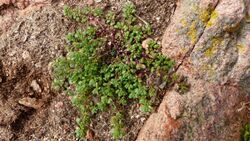Biology:Herniaria lusitanica subsp. berlengiana
| Herniaria lusitanica subsp. berlengiana | |
|---|---|

| |
| Scientific classification | |
| Kingdom: | Plantae |
| Clade: | Tracheophytes |
| Clade: | Angiosperms |
| Clade: | Eudicots |
| Order: | Caryophyllales |
| Family: | Caryophyllaceae |
| Genus: | Herniaria |
| Species: | |
| Subspecies: | H. l. subsp. berlengiana
|
| Trinomial name | |
| Herniaria lusitanica subsp. berlengiana Chaudhri
| |
| Synonyms[2] | |
| |
Herniaria lusitanica subsp. berlengiana is an endangered subspecies of flowering plant in the family Caryophyllaceae. It is endemic to the Berlengas Archipelago, Portugal.
Description
Herniaria lusitanica subsp. berlengiana is a biennal or perennial plant much smaller than its mainland counterpart (subsp. lusitanica). Stems are thin and grow up to about 5 cm (2.0 in), leaves are 4 mm × 2.25 mm (0.157 in × 0.089 in) and have short hairs, curly when young. Glomeruli have 4-7(10) flowers, 1–1.5 mm (0.039–0.059 in).[3]
Distribution and habitat
Herniaria lusitanica subsp. berlengiana inhabits the Berlengas on Berlenga Grande, the Farilhões Islets and Inês Islet 10 to 17 km (6.2 to 10.6 mi) off mainland Portugal. The plant has thin herbaceous communities growing mainly in arid sites, skeletal soils and in fissures of granite rocks as well as along hiking trails.[1][4]
Threats
It is mainly threatened by invasive plant species, namely the sour fig (Carpobrotus edulis), and clearing of hiking paths. Trampling is actually beneficial for this plant as it reduces its competition by keeping surrounding vegetation low.[1]
References
- ↑ 1.0 1.1 1.2 Caldas, F.B. (2011). "Herniaria lusitanica ssp. berlengiana". IUCN Red List of Threatened Species 2011: e.T162449A5592185. https://www.iucnredlist.org/species/162449/5592185. Retrieved 12 December 2020.
- ↑ "Herniaria lusitanica subsp. berlengiana Chaudhri". Catalogue of Life. https://www.catalogueoflife.org/data/taxon/5HNPF.
- ↑ "Herniaria". Flora Iberica. http://www.floraiberica.es/floraiberica/texto/pdfs/02_049_04_Herniaria.pdf.
- ↑ "Herniaria lusitanica subsp. berlengiana Chaudhri". Flora-on. https://flora-on.pt/#/0880.
Wikidata ☰ Q19709408 entry
 |


